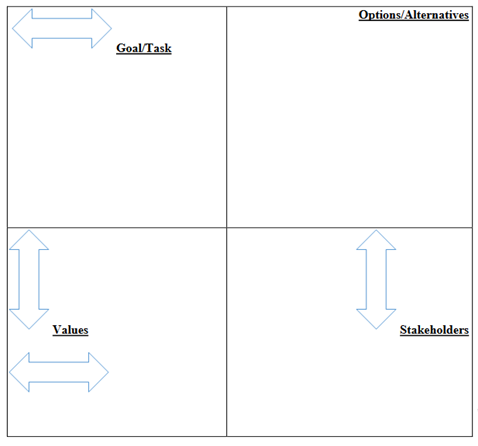Individuals and small groups taking part in OS usually have at least some discretions when it comes to deciding how to realise specific goals or fulfil specific tasks. The method described below is offered as one possible approach for improving such decision-making ethically and epistemically. The method is based on the ideal of “moral imagination” for scientific research developed by the philosopher of science Matthew Brown.1
This method is meant to be helpful in two interconnected ways:
- helping ensure that one’s research goal is realised/task fulfilled in a more responsible way ethically and epistemically by encouraging to think carefully about relevant values, norms, and stakeholders’ interests;
- helping ensure that one’s goal is realised/task fulfilled as fully as possible by encouraging to think imaginatively about different options (to multiply options), given the goal/task on the one hand, and relevant values, norms, and interests on the other.
You can use this method on your own or in a small group; even if you do it alone, it may be helpful to have discussions with colleagues.
To use this approach, start with the blank four-part table: goal/task; options/alternatives; values; stakeholders. The arrows indicate that different parts of the table are interconnected and one needs to be revised in light of the others. (Tab. 1).
Begin filling in the table: the initial formulation of the task/problem; initial ideas about options for realising it; the most obvious relevant values/norms and stakeholders.
Return to the table at least once to see how it can be revised:
- Think carefully about the relevant values/norms and stakeholders – do any need to be added? Are any of the included ones irrelevant/illegitimate and need to be removed? One of the aims of the normative framework is to attract attention to some less discussed considerations about values, normative issues, and stakeholders in OS.
- Think imaginatively about options – are there any less obvious good options for realising the goal while respecting the relevant values, norms and stakeholders’ interests? Are any of the options clearly problematic, given those values, norms and interests?
- Think about the formulation of the goal/task – can it be helpful/feasible to reformulate it, given the relevant values, norms and stakeholders’ interests on the one hand and the conceivable options on the other?
There is no set order to revising the table; there is no prescribed number of revisions – do it as many times as is feasible and feels productive.
Evaluate the list of options you have compiled. Choose the option to pursue. Is there one option that is clearly the best in the sense of being the most responsive to the relevant values and fair to the relevant stakeholders realizing the goal as fully as possible? Choose that.
However, there may be no unique option like that and there may be reasonable disagreement about which is better or which trade-off are acceptable. In such cases, make whatever choice you feel is the most acceptable, all things considered.
Importantly, this method does not presuppose that there is always (or ever) one definite correct decision. The hope is that thinking carefully about the values and stakeholders in connection to the goal will spur more creative thinking about options and better options emerge than the option that first comes to mind or the most habitual one.

Tab. 1 Adopted from Matthew Brown (2020). Science and Moral Imagination: A New Ideal for Values in Science. Pittsburgh: University of Pittsburgh Press (available at https://upittpress.org/books/9780822946267/).
[1] Brown M (2020). Science and Moral Imagination: A New Ideal for Values in Science. Pittsburgh: University
of Pittsburgh Press (available Open Access at https://upittpress.org/books/9780822946267/).
